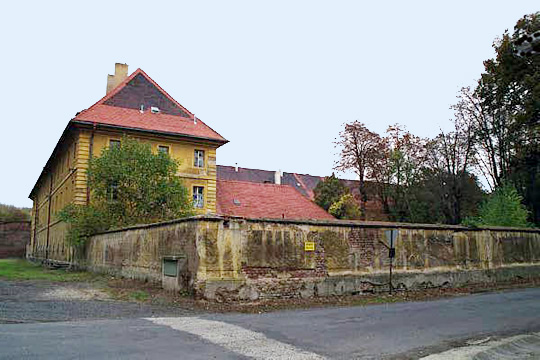Hohenelbe Barracks in Theresienstadt
 Theresienstadt hospital
was in the Hohenelbe barracks
Theresienstadt hospital
was in the Hohenelbe barracks
Between Parkstrasse and Wallstrasse on
the east side of the former Theresienstadt ghetto is the Hohenelbe
barracks shown in the photograph above. This was the central
hospital for the Jewish inmates in the ghetto. There were public
baths, showers and a swimming pool located here. The building
included a kitchen which prepared food for the hospital patients.
Behind this building is a large bastion
jutting out from the town walls which you can get a glimpse of
on the extreme left of the photo above. Located between the walls
of the bastion was the Kavalir barracks. This area served as
the processing center for incoming inmates in 1942, and the original
reception center, shown on the previous page, was converted into
a warehouse where clothing taken from the incoming prisoners
was stored. Later, the Kavalir barracks was used to house the
very old prisoners and also prisoners brought to Theresienstadt
from the Jewish insane asylums in the Greater German Reich. Some
of the insane people were placed in locked cells in the basement
where they had to sleep on bare stone floors. In September 1942
Jewish inmates of the Berlin Home for the Blind were put into
the Kavalir barracks.
Trudy Neuman was a patient in a mental
hospital in Vienna when she was deported to Theresienstadt in
1942 and put into the Kavalir barracks where she was forced to
live under horrible conditions before she died at age 52 on March
5, 1943. She was the daughter of Theodor Hertzl, the founder
of Zionism.
Hertzl was a journalist who wrote a book
called "The Jewish State" following the two trials
of Alfred Dreyfus on charges of espionage in France, which brought
to the attention of the world that Jews were forever being falsely
accused. His book was favorably received and in 1897, the first
meeting of the newly formed World Jewish Congress was held in
Switzerland. It was at this meeting that the subject of a Jewish
state was first seriously discussed. In 1948, these plans became
a reality when Israel became a Jewish state.
On the opposite side of the town, directly
in line with the Kavalir barracks, is another bastion where the
Sudeten barracks was located. The first transport of men who
arrived in the Theresienstadt ghetto on November 24, 1941 were
housed in the Sudeten barracks.
Two weeks later, on December 6, 1941,
the first group of women arrived and were quartered in the Dresden
barracks. In July 1943, the prisoners were evacuated from the
Sudeten barracks and the space was used to store the RSHA (Reich
Security Home Office) archives from Berlin to keep them safe
from destruction during the Allied bombing raids.
Close to the Sudeten barracks, but ouside
the walls of the town was the Südberg (South hill) where
the Nazis built a sports field for the Theresienstadt prisoners
in 1943. Both adults and children played soccer on this field.
|